Understanding the Value of a Seven Carat Diamond
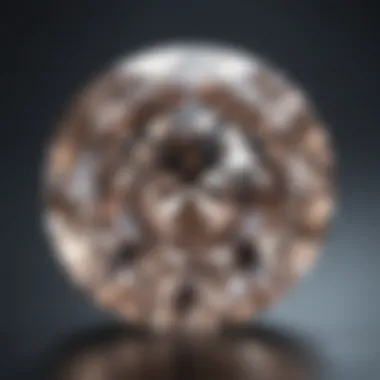
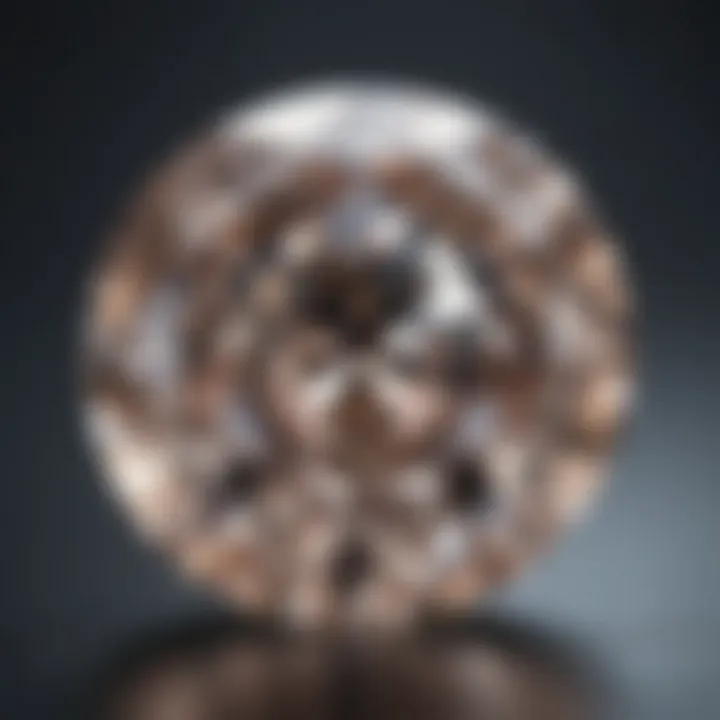
Intro
In the world of gemstones, diamonds stand out not just for their brilliance, but for the myriad narratives behind them. Among these, the seven carat diamond occupies a unique position. It serves as a focal point for enthusiasts, collectors, and even investors, highlighting both the beauty and complexities of this precious stone. Understanding the value of a seven carat diamond requires a deep dive into various factors, from market dynamics to the essential qualities that determine a diamond's allure.
Gemstone Overview
Definition and Origins
A diamond, fundamentally, is a crystalline form of carbon, known for its exceptional hardness and light dispersion qualities. Originating from deep within the Earth’s mantle, diamonds are brought to the surface through volcanic eruptions, where they have been uncovered and cherished for centuries. The term 'seven carats' refers not simply to the weight of the diamond but also signifies a breakpoint in the gemstone market. Larger stones, like a seven carat diamond, often attract greater attention and value than their smaller counterparts.
Historical Significance
Throughout history, diamonds have held a range of meanings and values, often tied to wealth and power. From the dazzling crowns of monarchs to engagement rings that symbolize eternal love, diamonds have woven themselves into the fabric of human expression. A seven carat diamond, due to its size and rarity, has often been associated with status, and for many cultures, it represents a significant life milestone.
Gemstone Properties
Hardness and Durability
Diamonds are renowned for their unparalleled hardness, rated at 10 on the Mohs scale. This characteristic makes them ideal not only for adornment but also for industrial applications. However, it’s essential to note that while diamonds are durable, they are not impervious. A sharp blow can cause a diamond to chip, so care must be taken when wearing larger stones like seven carat diamonds.
Color and Clarity
The beauty of a diamond is largely influenced by its color and clarity. Color ranges from completely colorless to shades that include subtle hints of yellow, brown, or even other hues. When one considers a seven carat diamond, even slight variances in color can drastically affect its market value. Clarity, which refers to the presence of internal or external imperfections, also plays a critical role.
Without clarity, a diamond loses its luster, much like a story that lacks coherence.
When assessing these gemstones, potential buyers should favor stones that are not only large but also exhibit clear, vibrant qualities. In essence, the combination of size, color, and clarity forms the backbone of a diamond's value.
For those keen to delve further, resources such as Wikipedia or Britannica provide a wealth of knowledge surrounding the nuances of diamonds and their market behaviors. Understanding these aspects can empower collectors and enthusiasts, fostering a more profound appreciation for what a seven carat diamond represents.
Understanding Diamond Weight
When it comes to diamonds, weight is a pivotal factor. Most buyers, whether they're seasoned collectors or first-time buyers, often lean heavily on the carat weight as a primary indicator of a diamond's value. In essence, carat weight encapsulates more than just the physical heft of the stone; it resonates with perceptions of luxury, significance, and investment potential. Understanding diamond weight is crucial for making informed choices. It helps in grasping what you get for your investment and how a diamond's appearance can be influenced by its size.
The Significance of Carat Weight
Carat weight serves as a universal standard in the diamond industry, but it brings baggage with it. A carat is equivalent to 200 milligrams, and diamonds are often grouped in points as well, where 100 points equals one carat. For example, a 1.5 carat diamond weighs 150 points. This fractional understanding comes in handy when evaluating options.
However, being fixated solely on the carat can lead to misjudgments. The old saying, "size matters," rings true in one aspect but can be a misstep if you overlook other important factors such as cut, color, and clarity. With a seven carat diamond, the allure of size is amplified. Such stones aren’t just rarities; they command attention wherever they go. One needs to consider that a larger diamond can reveal its true beauty and the nuances of its characteristics only when its quality is equally up to par.
"A larger diamond brings more than just size; it needs to wear its weight well, showcasing a beautiful play of light."
Carat Weight and Visual Impact
The visual impact of a diamond is oftentimes subject to more than what meets the eye and can vary dramatically based on the cut quality. Two diamonds of identical carat weight can still look strikingly different to the observer. That’s where the magic—or misfortunes—of diamond design comes into play.
For a seven carat diamond, the best proportions matter sublimely. A perfectly cut diamond will scintillate light beautifully, making it look larger than it really is. In contrast, a poorly cut diamond, even with higher weight, could appear smaller and less lustrous. A well-proportioned seven carat diamond ideally offers a balance, maximizing brightness while minimizing the body size to keep it from looking overly heavy.
Factors to contemplate include:
- Shape: The shape of the diamond affects its visual space, with certain shapes appearing larger due to their surface area.
- Setting: The style of the setting can either enhance or detract from the overall visual impact, with a delicate band drawing the eye to the diamond itself.
- Lighting: Different lighting can change the diamond's appearance; daylight can bring out sparkle while indoor lighting can soften its look.
In summary, understanding how weight translates into visual appeal is essential, especially when considering a hefty seven carat jewel. This knowledge will empower buyers, guiding them toward selections that truly resonate with both their sense of style and investment desires.
Quality Factors Influencing Value
When it comes to understanding the worth of a seven carat diamond, several factors undeniably play a significant role. These quality indicators can dictate not just the beauty of the stone but also its market appeal. Grasping the nuances of these aspects is crucial for anyone considering an investment in precious gems. The focus often zeroes in on the Four Cs: Cut, Color, Clarity, and Carat. Each of these elements carries its weight in determining the overall value, and knowing what sets them apart could mean a big difference in your decision.
The Four Cs of Diamonds
Cut
Cut refers to how well the diamond has been shaped and polished. It impacts the light performance of the stone, influencing its sparkle and brilliance. A well-cut diamond reflects light beautifully, which elevates its appeal and worth. In a seven carat diamond, the precision of the cut becomes even more critical. An excellent cut can make a diamond appear larger and enhance its visual allure. Without the perfect cut, even a hefty carat size can lose its charm.
One specific angle to consider is the table size, which refers to the flat top facet of a diamond. A well-proportioned table can amplify the diamond’s sparkle, making it seem more vivid. However, too large a table may diminish light performance, leading to a less desirable appearance. Therefore, while investing in a diamond, look for that harmonious balance in the cut—it's often the difference between just a pretty stone and a true masterpiece.
Color
Color is assessed on a scale from D (colorless) to Z (light yellow). A diamond with a color grade of D or E is often the most sought after since it allows for maximum light reflection. In a seven carat diamond, subtle changes in color can significantly affect its value. For instance, a near colorless diamond, graded G or H, may appear visually similar to a D or E but can be far more economical. This key trait makes color an essential aspect for buyers who are balancing budget and quality.
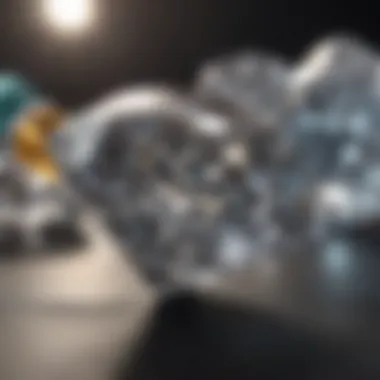

The unique feature of color in diamonds stems from their composite nature. Tiny traces of nitrogen or other elements can deeply influence a diamond’s hue and saturation. Thus, it’s prudent to analyze the color quality carefully. Opting for a slightly lower color grade can help stretch your dollar while still snagging a gorgeous piece.
Clarity
Clarity represents the absence of inclusions and blemishes in the diamond. The clarity scale ranges from Flawless (no inclusions visible under 10x magnification) to Included (inclusions visible to the naked eye). For a seven carat diamond, clarity can notably impact buyability. A relatively clean diamond with minimal inclusions retains higher value than one filled with visible imperfections.
Among clarity grades, VVS1 and VVS2 (Very Very Slightly Included) are considered advantageous choices, as they nearly appear flawless without the hefty price tag that comes with absolute perfection. One of the drawbacks is that inclusions can become more apparent in larger stones because of their size. Therefore, clarity becomes an integral aspect, influencing instant perception and hence the overall valuation.
Carat
Carat refers to the weight of the diamond, where one carat equals 200 milligrams. The size of a seven carat diamond undeniably makes it a standout piece. However, it’s important to understand how carat weight is perceived. A seven carat diamond, while impressive, can sometimes yield a lower price per carat due to the law of supply and demand; less demand often leads to decreased costs as sizes increase.
Additionally, larger diamonds may show slight proportions that affect how they appear. Factors like cut and clarity can actually overshadow the importance of carat in the eyes of certain buyers. Hence, one must step carefully; while carat weight conveys size, it’s often the combined synergy with the other Cs that creates a stone of true value.
How Each Quality Affects Price
Understanding how each of these quality factors interplays will directly influence the diamond's price is vital. Cut holds a high importance due to how it enhances light reflection, making the diamond appear more brilliant. Color usually plays a role in perceiving the diamond's purity. If one gets too caught up in chasing a higher carat without considering the other Cs, the investment might not deliver as expected.
On top of these individual influences, the overall perception of value shifts when one or more of the Cs shines. For example, a beautiful seven carat diamond with a good cut but lower clarity may still fetch a higher price than a smaller diamond with excellent clarity simply because of its size.
In summary, appreciating the complexities of the Four Cs helps when one gets into diamond pricing. Recognizing how cut, color, clarity, and carat come together can inform purchasing decisions, ensuring that both value and beauty are taken into account.
Market Dynamics: Pricing Trends
Understanding the market dynamics surrounding the pricing of diamonds, especially those that weigh seven carats, is crucial for anyone looking to navigate the diamond trade effectively. The value placed on diamonds isn't static; it fluctuates based on numerous factors ranging from demand and supply to economic conditions and cultural perceptions. By delving into the specifics of current market valuations and historical price trends, one can garner insights that not only enhance the knowledge about investment potential but also aid in making informed purchasing decisions.
Current Market Valuation
As of today, seven carat diamonds have garnered considerable attention in the luxury market, reflecting both exclusivity and a timeless aesthetic appeal. The current market valuation is influenced by the ongoing demand from affluent buyers seeking high-quality gemstones. Prices can range significantly based on the diamond's characteristics. For example, a well-cut, colorless, and flawless seven carat diamond can command a price upward of several hundred thousand dollars.
- Key Elements Affecting Valuation:
- Quality: Higher quality diamonds clearly hold more value, as per the Four Cs: Cut, Color, Clarity, and Carat.
- Market Demand: Trends among collectors and investors can shift the perceived value quickly.
- Economic Factors: Economic stability and fluctuations in disposable income influence buyer’s willingness to invest in luxury items.
Moreover, it's worth noting the role of online marketplaces where global buyers can compare prices. This accessibility can drive competition among sellers, creating opportunities for buyers looking for the best value.
Historical Price Trends
Tracing the historical price trends of diamonds reveals much about their perceived worth over time. It’s fascinating to consider how a seven carat gem, once a rarity, has seen fluctuations in its pricing based on socio-economic changes, technological advancements in diamond mining, and shifts in luxury markets. In the last few decades, there has been a noticeable increase in diamond prices, often attributed to rising demand in emerging economies and changes in cultural perceptions of diamond ownership.
- Notable Historical Insights:
- In the early 2000s, the price per carat for high-quality diamonds began to rise steadily, largely due to enhanced marketing efforts and a growing middle class in various countries.
- The 2008 financial crisis temporarily stunted diamond sales, leading to a dip in prices. However, recovery in the following years showed resilience, showcasing diamonds' role not just as luxury items, but also as investment assets.
- Recently, the popularity of lab-grown diamonds has stirred discussions about market impact, with prices being more accessible, causing buyers to shift their interests.
"Understanding historical trends offers a lens through which future investments can be gauged, providing context in an ever-evolving market."
Cultural Significance of Diamonds
Diamonds have been more than just beautiful gemstones for centuries; they carry deep-seated meaning across various cultures. From symbols of love and commitment to status and power, the significance of diamonds is multifaceted. Understanding this cultural backdrop is essential when assessing the value of a diamond, especially one as noteworthy as a seven carat gem. The emotional and cultural weight held by diamonds can elevate their value beyond mere market trends, influencing buyers' decisions and emotional ties to these stones.
Symbolism in Different Cultures
Throughout history, diamonds have been revered in myriad ways. In Western cultures, they are often synonymous with love and engagement, mainly due to the popularization of diamond rings in marriage proposals during the 20th century. Yet, their symbolism varies widely across the globe.
- India: Diamonds have a storied past in India, where they are regarded as a symbol of purity and marital bliss. They've been part of royal jewelry for centuries, flaunting immense value and craftsmanship.
- Africa: Many African societies interpret diamonds as symbols of power and wealth. The glittering stones can denote lineage and status, often passed down through generations as heirlooms.
- Asia: In some Asian cultures, diamonds signify prosperity and good fortune. People believe that wearing diamonds can attract wealth and happiness, making them highly sought after.
These cultural viewpoints shape buyers’ perceptions, elevating diamonds' significance beyond their physical attributes.
Diamonds in Historical Contexts
The historical context of diamonds is as glittering as the stones themselves. They have been coveted throughout human history, playing a key role in shaping trade routes, economies, and indeed, social hierarchies. The silk and spice trades of the ancient world were populated not only with say silk or spices but also with precious stones, including diamonds.
In medieval Europe, diamonds were associated with kings, queens, and nobility. One can recall that King Louis XIV of France used diamonds to showcase power, commissioning grand pieces of jewelry that not only embellished the royal figures but also demonstrated their wealth. Furthermore, during the late 19th century, the discovery of diamond mines in South Africa fundamentally altered the diamond market, shifting the dynamics of supply and demand.
- Trade and Commerce: Throughout history, diamonds have influenced economies, with significant trade routes emerging. The lands rich in diamonds became focal points for exploration and conquest.
- Cultural Artifacts: Many historical artifacts, such as crowns and ceremonial necklaces, feature diamonds set in intricate designs, symbolizing the legacy of empires and cultures.
As we observe how diamonds transitioned from being exclusive objects of royalty to widely valued jewels in modern society, we gain insight into their enduring influence. Their journey reflects shifts in societal values and wealth distributions, showcasing a rich tapestry of human history interwoven with the allure of these brilliant stones.
"Diamonds have transcended their status as mere adornments—they are mirrors reflecting the cultural, historical, and emotional values of the societies that cherish them."
Thus, when considering a seven carat diamond, its value is not simply a matter of market price; it is steeped in layers of cultural significance and historical legacy that buyers ought to thoroughly appreciate.
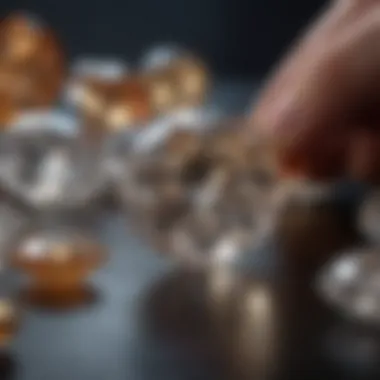
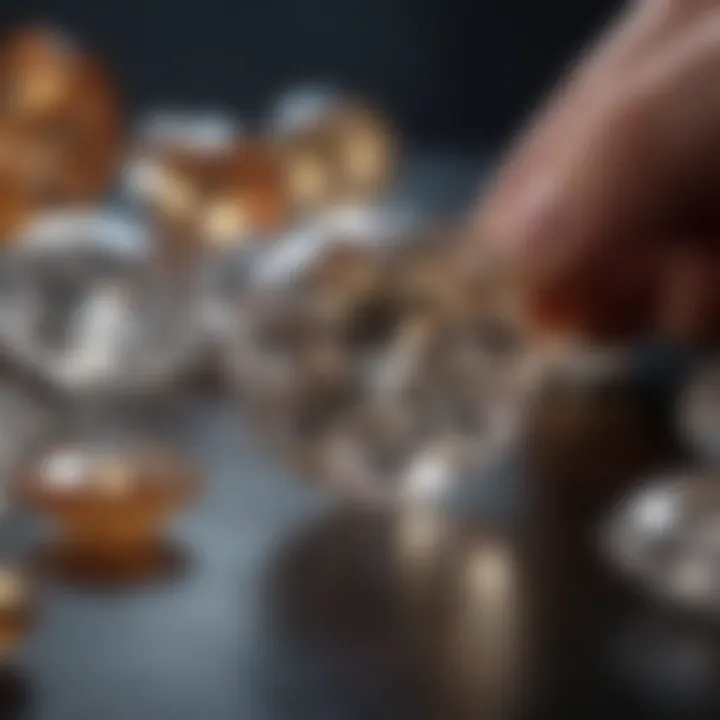
Ethical Considerations in Diamond Sourcing
In recent years, the conversation around ethical sourcing in the diamond industry has gained significant traction. Buyers today are becoming increasingly aware of the implications tied to their purchases. The value of a seven carat diamond goes beyond its aesthetic and monetary worth; it is now heavily influenced by the ethical considerations surrounding its sourcing. Understanding these elements is essential for buyers who wish to make informed decisions that align with their values.
Impact of Conflict Diamonds
Conflict diamonds, often referred to as "blood diamonds," pose a serious issue in the diamond trade. These gems are mined in war zones and sold to finance armed conflict, often in regions where human rights violations and exploitation are rampant. The impact of conflict diamonds is profound and multi-faceted, affecting not just the individuals involved in extraction but also the consumer market and global perceptions of diamond purchases.
The existence of conflict diamonds results in a tarnished reputation for the industry as a whole. Many consumers today prefer to steer clear of diamonds that might support such atrocities. It's no longer just about whether the diamond sparkles; people now think about where it comes from, who mined it, and under what circumstances. Modern buyers are often inclined to choose stones that promise ethical origins, which greatly reflects on their purchasing habits.
"A diamond is much more than a stone; it can symbolize a choice for humanity and ethics over conflict and suffering."
To combat the issue, organizations and initiatives like the Kimberley Process have been established, aiming to prevent the trade of conflict diamonds. Still, challenges persist, and the consumer is challenged to demand transparency when purchasing gems. Before investing in a seven carat diamond, it becomes crucial to ask questions about its background, ensuring that it holds not just beauty, but also integrity.
The Rise of Ethical Sourcing
In response to the growing concerns over conflict diamonds, there has been a notable rise in ethical sourcing practices within the diamond industry. Suppliers are increasingly adopting measures to ensure that their diamonds are conflict-free. This shift is not merely a marketing tactic; it reflects a significant change in the value system that drives both producers and consumers.
The growth of lab-grown diamonds is one aspect of this trend that can't be ignored. These diamonds, created through technological processes, offer an ethical alternative without the associated concerns of human rights violations. They possess the same physical and chemical properties as mined diamonds, often at a fraction of the cost, making them appealing to a broad audience.
In addition to lab-grown diamonds, many jewelers are now prioritizing sustainable mining practices. They are taking steps to ensure that their operations positively impact local communities, provide fair wages, and maintain environmental consciousness. Some are even sourcing from mines that follow responsible practices, adhering to rigorous ethical standards.
Interestingly, consumers are beginning to favor companies that openly share their sourcing practices. The era of silent luxury is giving way to informed decision-making, where buyers actively seek out jewelers who can verify the origins of their stones. Circumstances have changed, and a diamond's history has become an integral part of its value.
Investment Potential of Seven Carat Diamonds
When discussing the significance of a seven carat diamond, the conversation inevitably turns to its potential as an investment. Diamonds have long been regarded not just as beautiful adornments, but also as tangible assets that can appreciate over time. This particular weight class brings its own unique allure and benefits, making it a compelling option for both seasoned investors and newcomers alike.
Market as a Long-Term Investment
Investing in a seven carat diamond can be a wise choice for those looking to diversify their portfolios. Historically, diamond prices have shown resilience, even amid market fluctuations. The larger the carat weight, the more pronounced this phenomenon seems to be, as heavier stones are often seen as rare and desirable. People are even ready to pay a premium for diamonds above a certain threshold, typically above one carat.
Investors may find comfort in the fact that exceptional diamonds are in limited supply. Unlike stocks or currencies, a physical asset like a diamond does not lose value in the same way during an economic downturn. Instead, they often hold their ground, or sometimes even rise in value, particularly when demand outstrips supply. Some key reasons for this include:
- Rarity: A seven carat diamond is considerably rarer than a one carat or even a three carat gem. As the carat weight increases, the quantity available on the market diminishes significantly.
- Collector Demand: There’s a strong market for high-quality diamonds among collectors and investors. A seven carat diamond, especially one with excellent cut, color, and clarity, is often a sought-after item, which in turn drives up its desirability.
- Value Appreciation: Unlike cars or electronic gadgets that depreciate, a well-chosen diamond can actually appreciate in value over time. Many collectors view their diamond purchases as long-term investments.
"Buying a diamond is not just a transaction; it's an entry into a cyclical market that rewards patience and foresight."
Comparing with Other Investment Options
When weighing the prospects of investing in a seven carat diamond against more traditional avenues like stocks or real estate, certain key factors come into play.
- Liquidity: Diamonds typically do not offer the same liquidity as stocks, but they can be sold through specialized jewelers and auctions. This means they can be converted back into cash, albeit possibly at less transparent valuations.
- Market Volatility: Stocks can fluctuate wildly due to trader sentiment and economic conditions. Diamonds, being physical assets, tend to have more stable market valuations over time.
- Tangible Asset: There's something reassuring about having a physical object like a diamond. It's not a number on a screen; it’s a stunning gem you can hold and admire.
Investors should also consider the emotional aspect of diamond investments. Unlike purely financial assets, diamonds have intrinsic beauty and emotional value, providing both financial and sentimental rewards. Having a diamond can be a source of pride, heirloom potential, or simply a beautiful piece of art to cherish.
In summary, the investment potential of a seven carat diamond is multifaceted and worthy of careful consideration. By understanding the dynamics of the diamond market and the unique qualities that make large stones desirable, investors can make informed decisions that go beyond mere numbers and forecasts.
Buying Considerations for Prospective Buyers
When entering the world of diamond purchasing, especially for a gemstone as unique as a seven carat diamond, the considerations extend far beyond mere aesthetics. This section aims to guide prospective buyers through the intricacies of what to observe, ponder, and prepare before making a significant investment. Understanding the core factors involved in buying such a high-value diamond can save both time and money, and drastically influence the satisfaction of your choice.
What to Look for in a Seven Carat Diamond
In the search for a seven carat diamond, one must look closely at a handful of essential features that can greatly affect both its allure and its price. Here are some key elements to keep in mind:
- The Four Cs: Familiarize yourself with Carat, Cut, Color, and Clarity. Each of these aspects has a unique impact on how the diamond looks and its overall value.
- Certification: Always seek diamonds that come with certification from reputable gemological laboratories like the Gemological Institute of America (GIA) or the American Gem Society (AGS). A valid certification ensures that the diamond’s quality attributes are accurately described.
- Market Trends: Keep an ear to the ground regarding current market conditions. Prices can fluctuate based on demand, economic factors, and advancements in technology that affect both natural and lab-grown diamonds.
- Cut: A diamond’s cut determines how well it reflects light and thus its spark none can rival. A well-cut stone can dazzle one to glory, while a poorly cut one can appear dull even if it is large.
- Color: Diamonds range in color from completely clear to shades of yellow or brown. Generally, the less color, the more valuable.
- Clarity: This measures the number of internal inclusions and surface flaws. A diamond free from visible blemishes is typically more coveted.
"An informed buyer holds the key to snagging not just a stone, but a treasure."
- Return Policy and Warranty: It’s important to clarify return policies and warranty options. A trustworthy jeweler will have sound policies that will protect your investment. This is especially crucial when dealing with significant purchases such as a seven carat diamond.
Tips for Negotiating Purchase
Negotiation can often feel like a daunting task, especially for such a precious item. However, a good strategy can result in better terms, a lower price, or even added value. Here are some helpful tips for effectively negotiating your diamond purchase:
- Do Your Homework: Knowledge is power. Research diamonds similar to the one you’re eyeing regarding price, quality, and market dynamics.
- Set a Budget: Before walking into a jewelry store, determine your maximum spend. This clarity helps in negotiations and prevents you from being swayed into overspending.
- Be Ready to Walk Away: Sometimes, the ability to leave negotiations can have a powerful impact. It shows the seller you are serious about finding the right deal, not just a sale.
- Bundle Offer: If you’re looking at multiple items, consider negotiating for a bundle deal. Retailers are often more willing to cut a better deal if they see a larger sale potential.
- Ask for Extras: During negotiations, don’t shy away from asking for additional benefits like a free insurance appraisal or a complimentary cleaning and maintenance kit.
- Writing It Down: Ensure that whatever agreements you reach are documented. This can safeguard you from any miscommunication post-purchase.
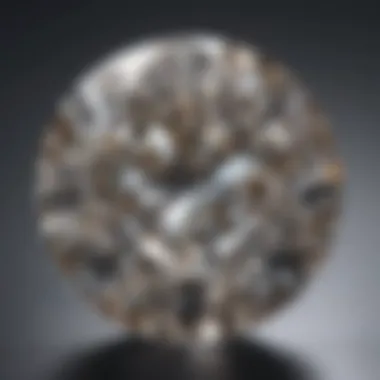
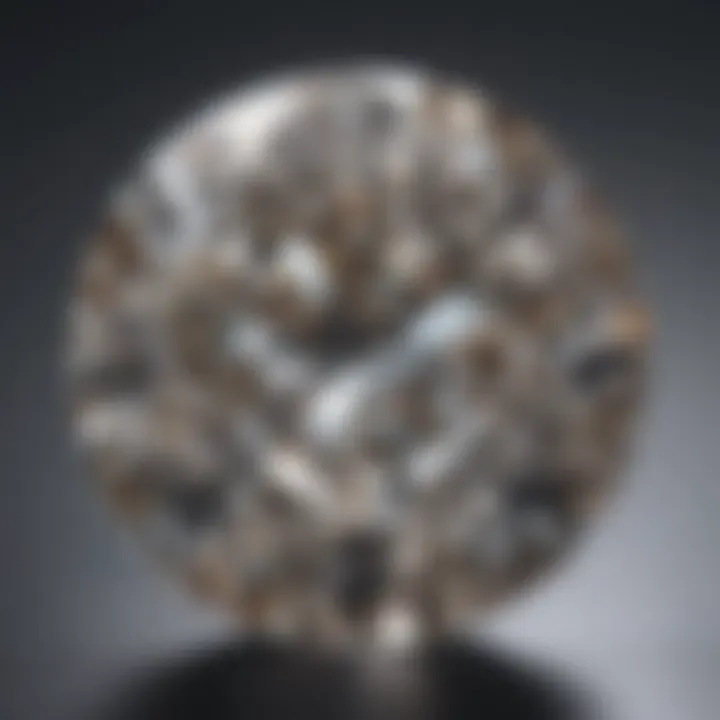
By keeping these insights close to your chest, prospective buyers can navigate the diamond buying experience with a bit more confidence and clarity. Remember, a seven carat diamond is not just a piece of jewelry; it’s a lasting treasure that deserves thoughtful consideration.
Care and Maintenance of Diamonds
When it comes to maintaining the beauty and longevity of a seven carat diamond, care and maintenance play a pivotal role. Often regarded as a symbol of wealth and status, diamonds—particularly those of this size—require thoughtful attention. Proper maintenance not only preserves their brilliance but also protects their value in a competitive market.
Cleaning and Storage Practices
Your diamond jewelry deserves a tender touch. Regular cleaning is crucial. It’s not just about aesthetics; dirt and oils can cloud the stone’s shine. Here are some tried-and-true practices for ensuring a sparkling surface:
- Gentle Soap Solution: A mixture of warm water and mild dish soap can do wonders. Dip a soft-bristled toothbrush in this solution and gently scrub the diamond. Avoid harsh chemicals; they can harm the stone’s integrity.
- Rinse and Dry Correctly: After cleaning, rinse it thoroughly under running water, making sure all soap residue is gone. Then, dry with a lint-free cloth to prevent scratches.
- Professional Cleaning: Periodically, consider taking your piece to a jeweler for professional cleaning. They have expertise in handling diamonds and can opt for ultrasonic cleaning if necessary, assuring no harm comes to the stone.
Storage is equally important. Keep your diamond jewelry away from other pieces to avoid scratches. A dedicated jewelry box with individual compartments, or even a soft pouch, can suffice. Avoid keeping diamonds in direct sunlight or extreme temperatures, as this might diminish their beauty over time.
Insurance and Protection Strategies
Securing your investment is a wise move, especially with high-value items like a seven carat diamond. Insurance should be at the forefront of your planning. Here’s what buyers should consider:
- Appraisal: First off, get your diamond appraised by a certified gemologist. This establishes its value and is essential for insurance purposes.
- Choose the Right Policy: Look for insurance that covers theft, loss, and damage. Some policies specifically cater to jewelry and offer better protection than standard homeowners' insurance.
- Backup Documentation: Always keep copies of your insurance policy, clean appraisal reports, and photographs of the diamond. Having this documentation handy ensures a smoother claims process if needed.
Additionally, consider protection strategies such as:
- Secure your valuables: A safe deposit box or a home safe designed for valuables can be prime options for keeping your diamond secure.
- Regular Check-ups: Have your jewelery inspected periodically to catch any wear and tear before it becomes detrimental.
"A well-maintained diamond is not just a sparkling gem—it’s an unchanging part of your legacy."
Emerging Trends in the Diamond Market
The diamond market, much like the gems it showcases, is constantly evolving. The emerging trends represent not only changes in consumer preferences but also shifts in technology, ethics, and environmental considerations. For those interested in seven carat diamonds, understanding these trends is crucial. Not only does it provide insight into the present market landscape, but it also helps anticipate future movements and value appreciation.
Lab-Grown Diamonds vs. Natural Diamonds
The debate between lab-grown diamonds and natural diamonds is becoming a central talking point in the industry. Lab-grown diamonds, created through technological processes that simulate natural conditions, are increasingly popular. One key factor driving this trend is the price point; typically, lab-grown diamonds can be substantially less expensive, often around 30-40% cheaper than their natural counterparts. This makes them attractive to budget-conscious buyers.
Moreover, lab-grown diamonds offer consistency in quality and lower carbon footprints, aligning with a rising consumer interest in sustainability.
Conversely, natural diamonds carry immense traditional value and historical significance. Many buyers view them as irreplaceable symbols of love and commitment, often associated with emotional and cultural narratives.
"As consumer values shift towards sustainability, the allure of lab-grown diamonds burgeons. Yet, many still cling to the romance embedded within natural diamonds."
Both types have their appeals, and they can complement each other in the market. However, as lab-grown diamonds gain traction, prospective buyers of seven carat diamonds will need to consider what matters most: authenticity, price, or sustainability.
Innovations in Diamond Technology
Technology continues to reshape the diamond landscape, opening doors that may have seemed locked. Innovations encompass a wide range of fields like mining techniques, synthetic production methods, and various platforms for buying and selling diamonds.
For example, advancements in 3D imaging and AI analytics have made it easier for consumers to assess quality remotely, enabling informed purchasing decisions without requiring in-person examination. This is particularly beneficial for those looking to invest in larger diamonds, such as a seven carat stone.
Another noteworthy trend is the use of blockchain technology to ensure transparency and authenticity in diamond transactions. This system allows buyers to trace the origin and journey of a diamond, ensuring not only quality but ethical sourcing as well. For buyers, knowing that their diamond isn't coming from a conflict zone or an unethical source is pivotal.
Additionally, the rise of online marketplaces tailored specifically for diamonds has changed shopping habits significantly. These platforms offer more variety and competitive prices, appealing especially to a savvy, younger consumer base.
In summary, the trends of lab-grown diamonds and advancements in technology present rich ground for exploration. They shape consumer choices and influence the value of diamonds in ways that are often nuanced yet crucial, particularly when dealing with significant purchases like seven carat diamonds.
End
The conclusion of this article serves as a vital exposition of the various aspects surrounding the value of a seven carat diamond. Within these discussions, we've traversed from understanding the fundamentals of carat weight, quality factors, and market dynamics, to cultural significances and ethical considerations. This multi-faceted exploration delineates not only the facets contributing to the valuation of such a gemstone but also highlights multiple perspectives that resonant with gemstone enthusiasts and potential buyers alike.
This article emphasizes that each diamond is not merely a product, but a symbol laced with history, culture, and personal significance. Particularly in the case of a seven carat diamond, the implications of ownership stretch far beyond its market value; they afford the buyer a canvas of emotion, memory, and perhaps investment opportunity. The discussions around quality markers like cut and clarity serve as indispensable knowledge for anyone looking to enter this investment terrain.
Consequently, understanding the intricate layers of value molded by market dynamics is essential. The rise of ethical sourcing further accentuates the necessity for buyers to make informed decisions, enhancing not just their purchases but also their conscience.
"Every diamond has a story to tell, and a seven carat diamond carries the weight of many chapters within it."
In summary, delving deep into what influences the value of a seven carat diamond enriches one's appreciation for these stones and cultivates a more nuanced perspective when engaging in the jewelry marketplace or as a collector. Knowledge is power, and in the realm of fine gems, it opens doors to understanding rarity, beauty, and the diamond's journey from mine to market.
Recap of Key Insights
The insights elaborated within this article underscore several pivotal elements in understanding the value of a seven carat diamond:
- Carat Weight: The significant impact on visual allure and investment potential.
- The Four Cs: Valuable criteria—cut, color, clarity, and carat—that directly influence a diamond's desirability and pricing.
- Market Trends: An exploration of current valuations, historical patterns, and cultural significances that shape buyer perceptions.
- Ethical Sourcing: The increasing importance of sourcing diamonds responsibly, catering to socially conscious consumers.
- Investment Potential: The analysis of a seven carat diamond as both a luxury item and a viable long-term investment.
Final Thoughts on Value of a Seven Carat Diamond
When it comes to evaluating a seven carat diamond, it is crucial to grasp the broader narratives that intertwine with its existence; this encompasses not only aesthetic appreciation but also the ethical implications of its acquisition. The dual nature of diamonds as objects of beauty and as investment vehicles elevates their perceived value, transforming each choice into a reflection of personal values and aspirations.
Ultimately, understanding what makes a seven carat diamond stand out requires delving beyond surface-level aspects. It’s about acknowledging the craftsmanship, the emotional resonance, and the impact of each purchase decision. As the market continues to evolve, those who possess a deep understanding of these dynamics will better navigate the often tumultuous waters of diamond purchasing and collecting.



